Comprehensive Plan: New Government Structure of Nepal
VerifiedAdded on 2022/08/10
|6
|1387
|392
Essay
AI Summary
This essay presents a comprehensive plan for the new government structure of Nepal, addressing the nation's political landscape following a transition from a dictatorial regime. The author explores domestic concerns, including political instability and natural disasters, while also examining foreign concerns such as border disputes and illicit activities. The essay outlines the governing style, principles, and functions of the government branches. It proposes effective domestic programs focused on infrastructure and renewable energy. The essay also emphasizes the importance of national unity and suggests strategies to combat terrorism. Furthermore, it discusses the role of international organizations in ensuring Nepal's security and development, offering insights into the country's future direction.
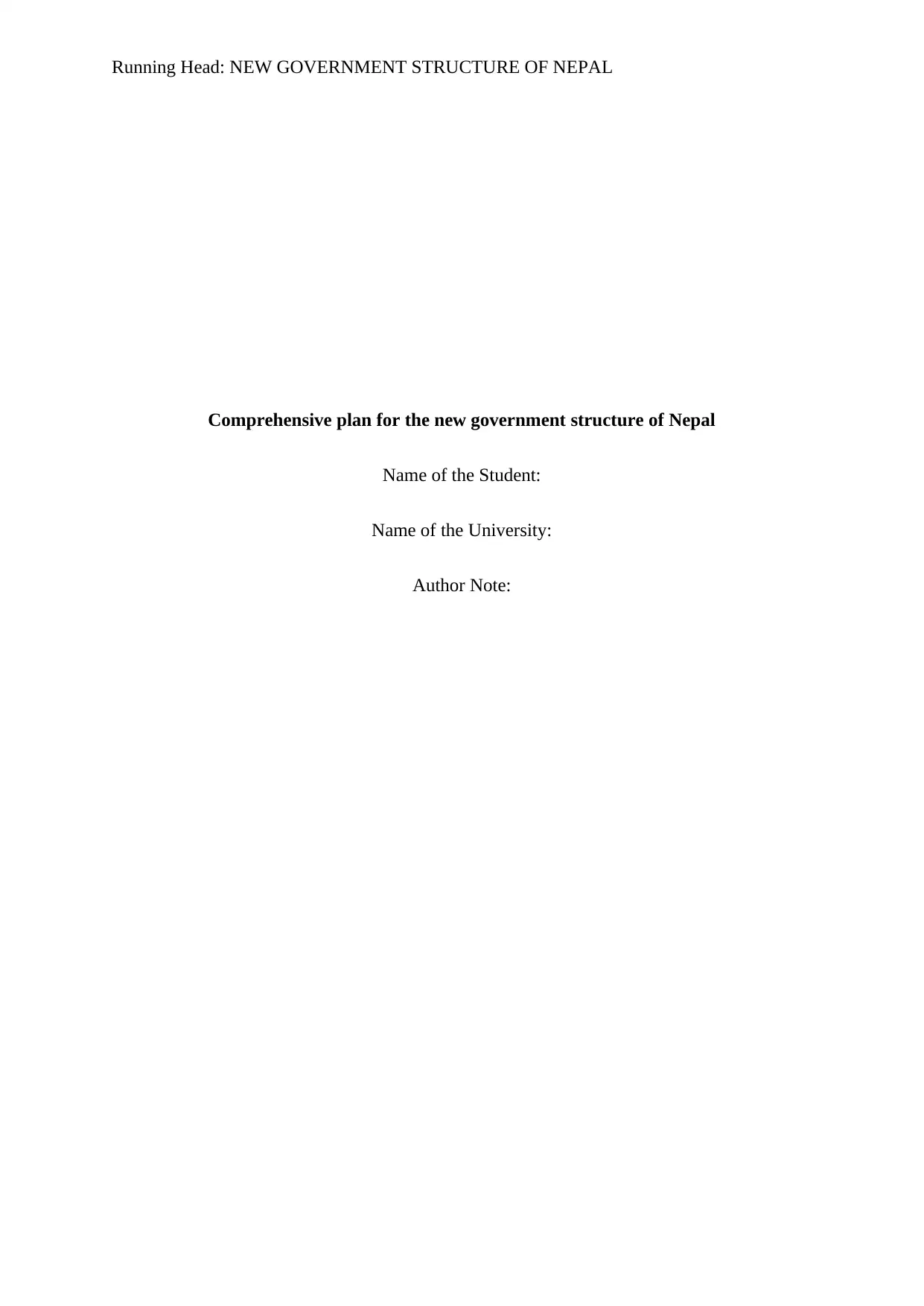
Running Head: NEW GOVERNMENT STRUCTURE OF NEPAL
Comprehensive plan for the new government structure of Nepal
Name of the Student:
Name of the University:
Author Note:
Comprehensive plan for the new government structure of Nepal
Name of the Student:
Name of the University:
Author Note:
Paraphrase This Document
Need a fresh take? Get an instant paraphrase of this document with our AI Paraphraser
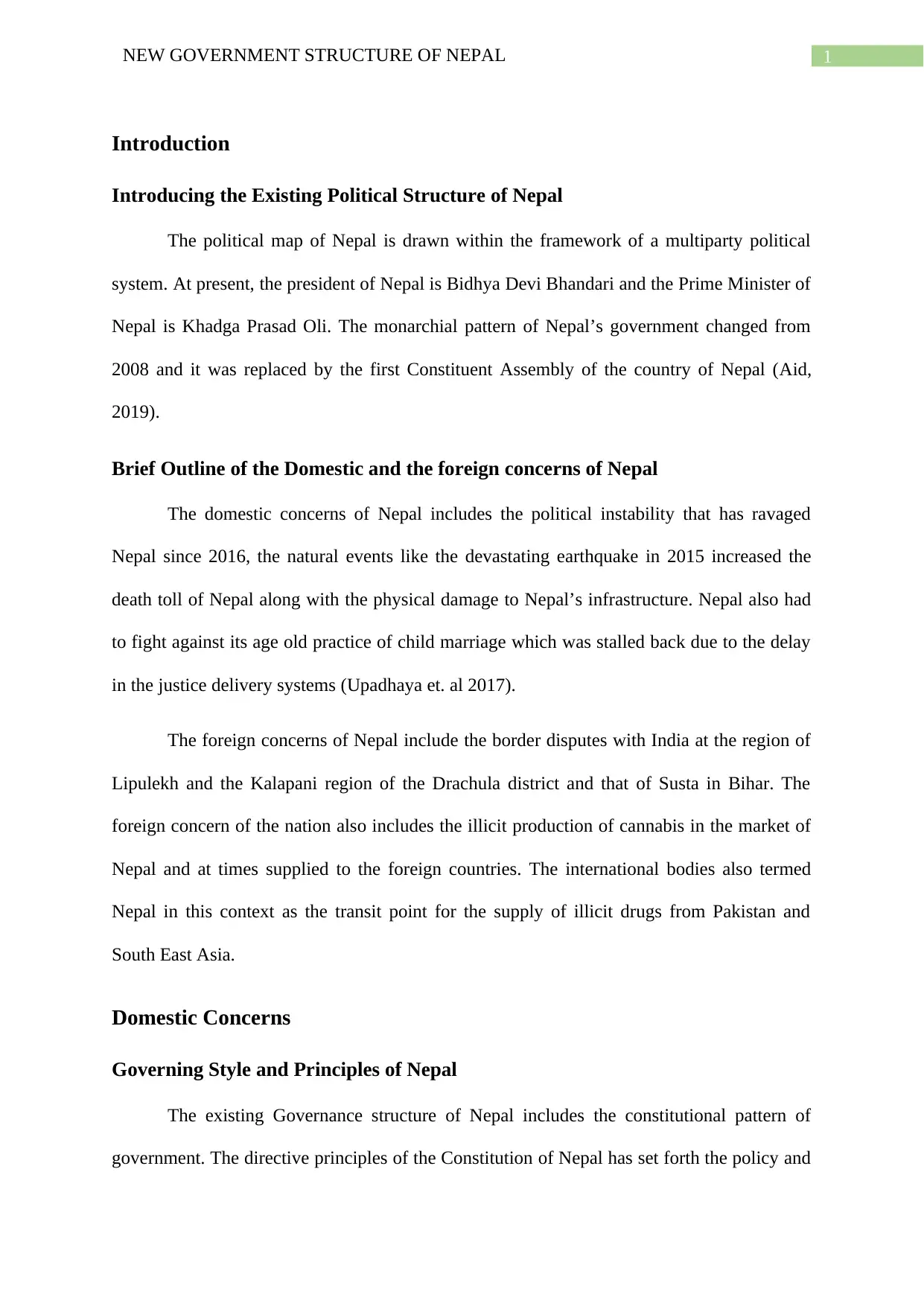
1NEW GOVERNMENT STRUCTURE OF NEPAL
Introduction
Introducing the Existing Political Structure of Nepal
The political map of Nepal is drawn within the framework of a multiparty political
system. At present, the president of Nepal is Bidhya Devi Bhandari and the Prime Minister of
Nepal is Khadga Prasad Oli. The monarchial pattern of Nepal’s government changed from
2008 and it was replaced by the first Constituent Assembly of the country of Nepal (Aid,
2019).
Brief Outline of the Domestic and the foreign concerns of Nepal
The domestic concerns of Nepal includes the political instability that has ravaged
Nepal since 2016, the natural events like the devastating earthquake in 2015 increased the
death toll of Nepal along with the physical damage to Nepal’s infrastructure. Nepal also had
to fight against its age old practice of child marriage which was stalled back due to the delay
in the justice delivery systems (Upadhaya et. al 2017).
The foreign concerns of Nepal include the border disputes with India at the region of
Lipulekh and the Kalapani region of the Drachula district and that of Susta in Bihar. The
foreign concern of the nation also includes the illicit production of cannabis in the market of
Nepal and at times supplied to the foreign countries. The international bodies also termed
Nepal in this context as the transit point for the supply of illicit drugs from Pakistan and
South East Asia.
Domestic Concerns
Governing Style and Principles of Nepal
The existing Governance structure of Nepal includes the constitutional pattern of
government. The directive principles of the Constitution of Nepal has set forth the policy and
Introduction
Introducing the Existing Political Structure of Nepal
The political map of Nepal is drawn within the framework of a multiparty political
system. At present, the president of Nepal is Bidhya Devi Bhandari and the Prime Minister of
Nepal is Khadga Prasad Oli. The monarchial pattern of Nepal’s government changed from
2008 and it was replaced by the first Constituent Assembly of the country of Nepal (Aid,
2019).
Brief Outline of the Domestic and the foreign concerns of Nepal
The domestic concerns of Nepal includes the political instability that has ravaged
Nepal since 2016, the natural events like the devastating earthquake in 2015 increased the
death toll of Nepal along with the physical damage to Nepal’s infrastructure. Nepal also had
to fight against its age old practice of child marriage which was stalled back due to the delay
in the justice delivery systems (Upadhaya et. al 2017).
The foreign concerns of Nepal include the border disputes with India at the region of
Lipulekh and the Kalapani region of the Drachula district and that of Susta in Bihar. The
foreign concern of the nation also includes the illicit production of cannabis in the market of
Nepal and at times supplied to the foreign countries. The international bodies also termed
Nepal in this context as the transit point for the supply of illicit drugs from Pakistan and
South East Asia.
Domestic Concerns
Governing Style and Principles of Nepal
The existing Governance structure of Nepal includes the constitutional pattern of
government. The directive principles of the Constitution of Nepal has set forth the policy and
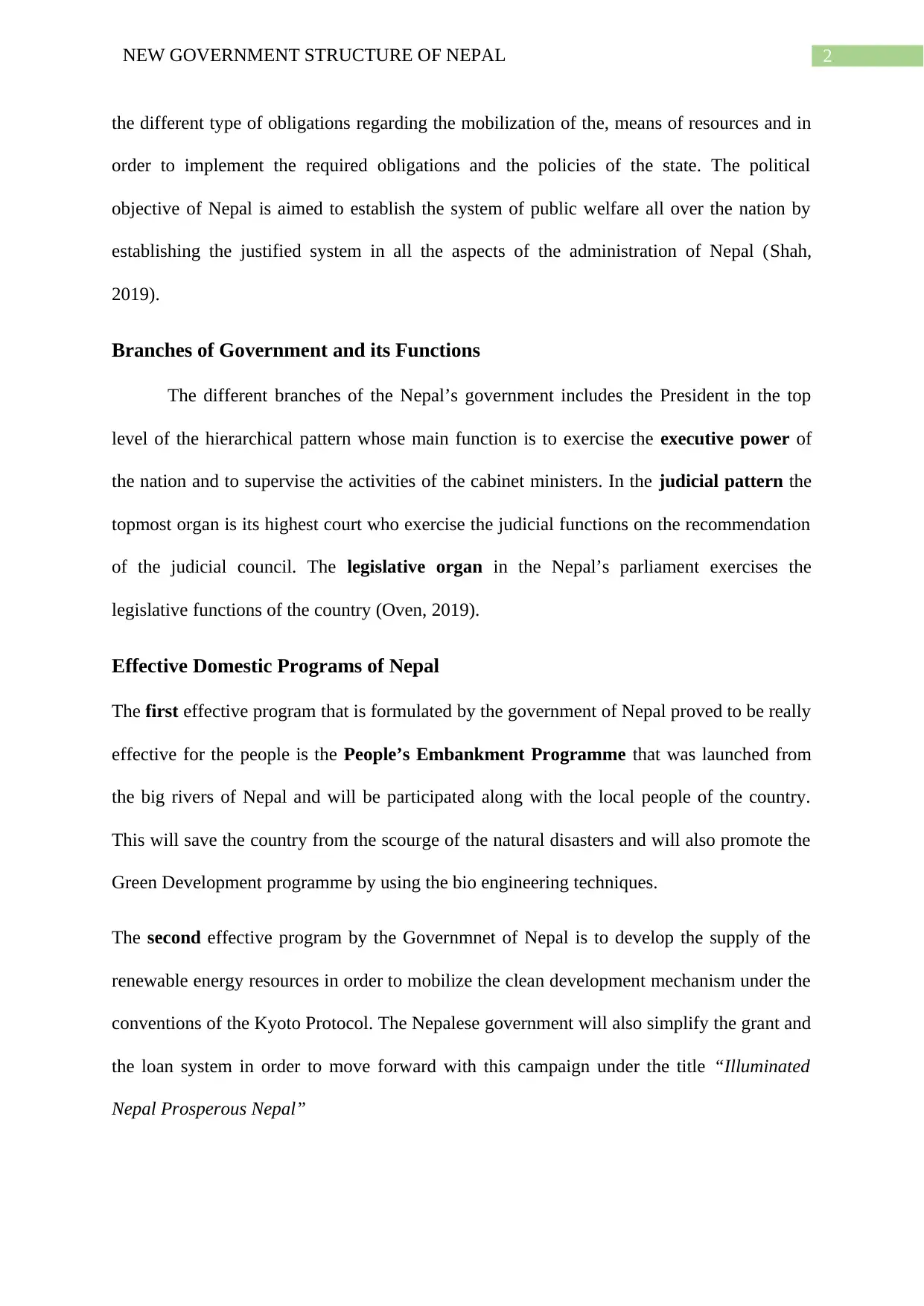
2NEW GOVERNMENT STRUCTURE OF NEPAL
the different type of obligations regarding the mobilization of the, means of resources and in
order to implement the required obligations and the policies of the state. The political
objective of Nepal is aimed to establish the system of public welfare all over the nation by
establishing the justified system in all the aspects of the administration of Nepal (Shah,
2019).
Branches of Government and its Functions
The different branches of the Nepal’s government includes the President in the top
level of the hierarchical pattern whose main function is to exercise the executive power of
the nation and to supervise the activities of the cabinet ministers. In the judicial pattern the
topmost organ is its highest court who exercise the judicial functions on the recommendation
of the judicial council. The legislative organ in the Nepal’s parliament exercises the
legislative functions of the country (Oven, 2019).
Effective Domestic Programs of Nepal
The first effective program that is formulated by the government of Nepal proved to be really
effective for the people is the People’s Embankment Programme that was launched from
the big rivers of Nepal and will be participated along with the local people of the country.
This will save the country from the scourge of the natural disasters and will also promote the
Green Development programme by using the bio engineering techniques.
The second effective program by the Governmnet of Nepal is to develop the supply of the
renewable energy resources in order to mobilize the clean development mechanism under the
conventions of the Kyoto Protocol. The Nepalese government will also simplify the grant and
the loan system in order to move forward with this campaign under the title “Illuminated
Nepal Prosperous Nepal”
the different type of obligations regarding the mobilization of the, means of resources and in
order to implement the required obligations and the policies of the state. The political
objective of Nepal is aimed to establish the system of public welfare all over the nation by
establishing the justified system in all the aspects of the administration of Nepal (Shah,
2019).
Branches of Government and its Functions
The different branches of the Nepal’s government includes the President in the top
level of the hierarchical pattern whose main function is to exercise the executive power of
the nation and to supervise the activities of the cabinet ministers. In the judicial pattern the
topmost organ is its highest court who exercise the judicial functions on the recommendation
of the judicial council. The legislative organ in the Nepal’s parliament exercises the
legislative functions of the country (Oven, 2019).
Effective Domestic Programs of Nepal
The first effective program that is formulated by the government of Nepal proved to be really
effective for the people is the People’s Embankment Programme that was launched from
the big rivers of Nepal and will be participated along with the local people of the country.
This will save the country from the scourge of the natural disasters and will also promote the
Green Development programme by using the bio engineering techniques.
The second effective program by the Governmnet of Nepal is to develop the supply of the
renewable energy resources in order to mobilize the clean development mechanism under the
conventions of the Kyoto Protocol. The Nepalese government will also simplify the grant and
the loan system in order to move forward with this campaign under the title “Illuminated
Nepal Prosperous Nepal”
⊘ This is a preview!⊘
Do you want full access?
Subscribe today to unlock all pages.

Trusted by 1+ million students worldwide
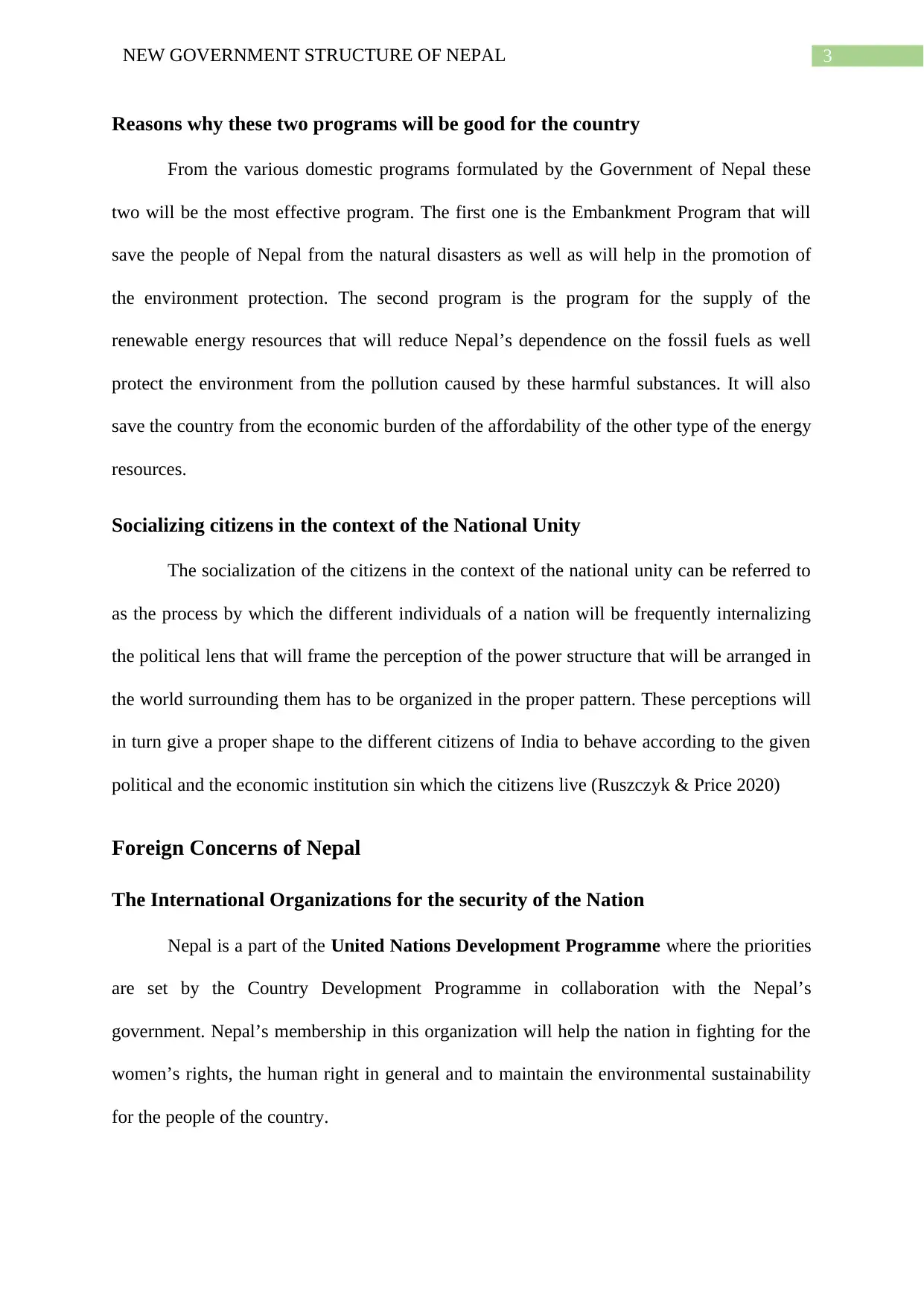
3NEW GOVERNMENT STRUCTURE OF NEPAL
Reasons why these two programs will be good for the country
From the various domestic programs formulated by the Government of Nepal these
two will be the most effective program. The first one is the Embankment Program that will
save the people of Nepal from the natural disasters as well as will help in the promotion of
the environment protection. The second program is the program for the supply of the
renewable energy resources that will reduce Nepal’s dependence on the fossil fuels as well
protect the environment from the pollution caused by these harmful substances. It will also
save the country from the economic burden of the affordability of the other type of the energy
resources.
Socializing citizens in the context of the National Unity
The socialization of the citizens in the context of the national unity can be referred to
as the process by which the different individuals of a nation will be frequently internalizing
the political lens that will frame the perception of the power structure that will be arranged in
the world surrounding them has to be organized in the proper pattern. These perceptions will
in turn give a proper shape to the different citizens of India to behave according to the given
political and the economic institution sin which the citizens live (Ruszczyk & Price 2020)
Foreign Concerns of Nepal
The International Organizations for the security of the Nation
Nepal is a part of the United Nations Development Programme where the priorities
are set by the Country Development Programme in collaboration with the Nepal’s
government. Nepal’s membership in this organization will help the nation in fighting for the
women’s rights, the human right in general and to maintain the environmental sustainability
for the people of the country.
Reasons why these two programs will be good for the country
From the various domestic programs formulated by the Government of Nepal these
two will be the most effective program. The first one is the Embankment Program that will
save the people of Nepal from the natural disasters as well as will help in the promotion of
the environment protection. The second program is the program for the supply of the
renewable energy resources that will reduce Nepal’s dependence on the fossil fuels as well
protect the environment from the pollution caused by these harmful substances. It will also
save the country from the economic burden of the affordability of the other type of the energy
resources.
Socializing citizens in the context of the National Unity
The socialization of the citizens in the context of the national unity can be referred to
as the process by which the different individuals of a nation will be frequently internalizing
the political lens that will frame the perception of the power structure that will be arranged in
the world surrounding them has to be organized in the proper pattern. These perceptions will
in turn give a proper shape to the different citizens of India to behave according to the given
political and the economic institution sin which the citizens live (Ruszczyk & Price 2020)
Foreign Concerns of Nepal
The International Organizations for the security of the Nation
Nepal is a part of the United Nations Development Programme where the priorities
are set by the Country Development Programme in collaboration with the Nepal’s
government. Nepal’s membership in this organization will help the nation in fighting for the
women’s rights, the human right in general and to maintain the environmental sustainability
for the people of the country.
Paraphrase This Document
Need a fresh take? Get an instant paraphrase of this document with our AI Paraphraser
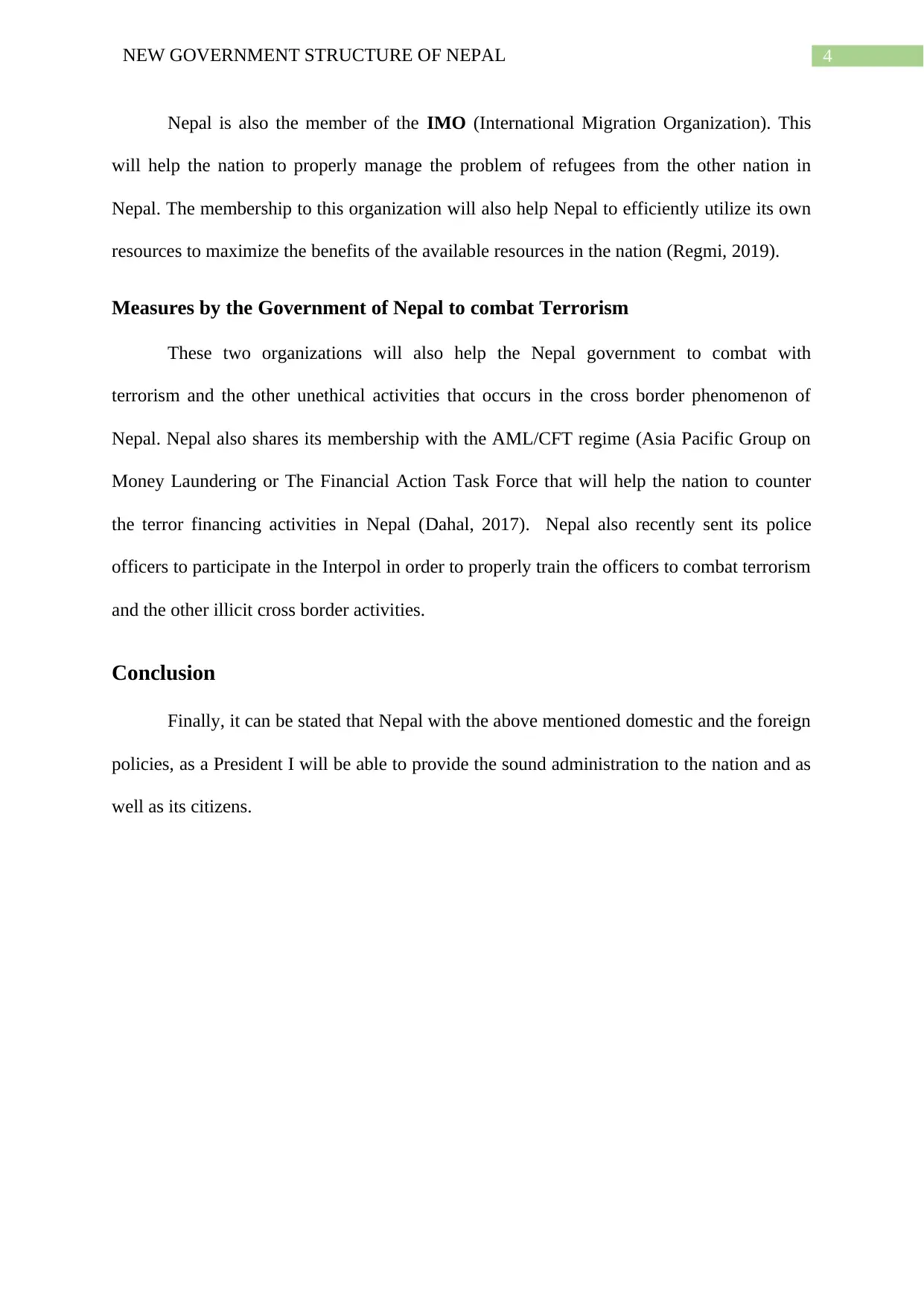
4NEW GOVERNMENT STRUCTURE OF NEPAL
Nepal is also the member of the IMO (International Migration Organization). This
will help the nation to properly manage the problem of refugees from the other nation in
Nepal. The membership to this organization will also help Nepal to efficiently utilize its own
resources to maximize the benefits of the available resources in the nation (Regmi, 2019).
Measures by the Government of Nepal to combat Terrorism
These two organizations will also help the Nepal government to combat with
terrorism and the other unethical activities that occurs in the cross border phenomenon of
Nepal. Nepal also shares its membership with the AML/CFT regime (Asia Pacific Group on
Money Laundering or The Financial Action Task Force that will help the nation to counter
the terror financing activities in Nepal (Dahal, 2017). Nepal also recently sent its police
officers to participate in the Interpol in order to properly train the officers to combat terrorism
and the other illicit cross border activities.
Conclusion
Finally, it can be stated that Nepal with the above mentioned domestic and the foreign
policies, as a President I will be able to provide the sound administration to the nation and as
well as its citizens.
Nepal is also the member of the IMO (International Migration Organization). This
will help the nation to properly manage the problem of refugees from the other nation in
Nepal. The membership to this organization will also help Nepal to efficiently utilize its own
resources to maximize the benefits of the available resources in the nation (Regmi, 2019).
Measures by the Government of Nepal to combat Terrorism
These two organizations will also help the Nepal government to combat with
terrorism and the other unethical activities that occurs in the cross border phenomenon of
Nepal. Nepal also shares its membership with the AML/CFT regime (Asia Pacific Group on
Money Laundering or The Financial Action Task Force that will help the nation to counter
the terror financing activities in Nepal (Dahal, 2017). Nepal also recently sent its police
officers to participate in the Interpol in order to properly train the officers to combat terrorism
and the other illicit cross border activities.
Conclusion
Finally, it can be stated that Nepal with the above mentioned domestic and the foreign
policies, as a President I will be able to provide the sound administration to the nation and as
well as its citizens.
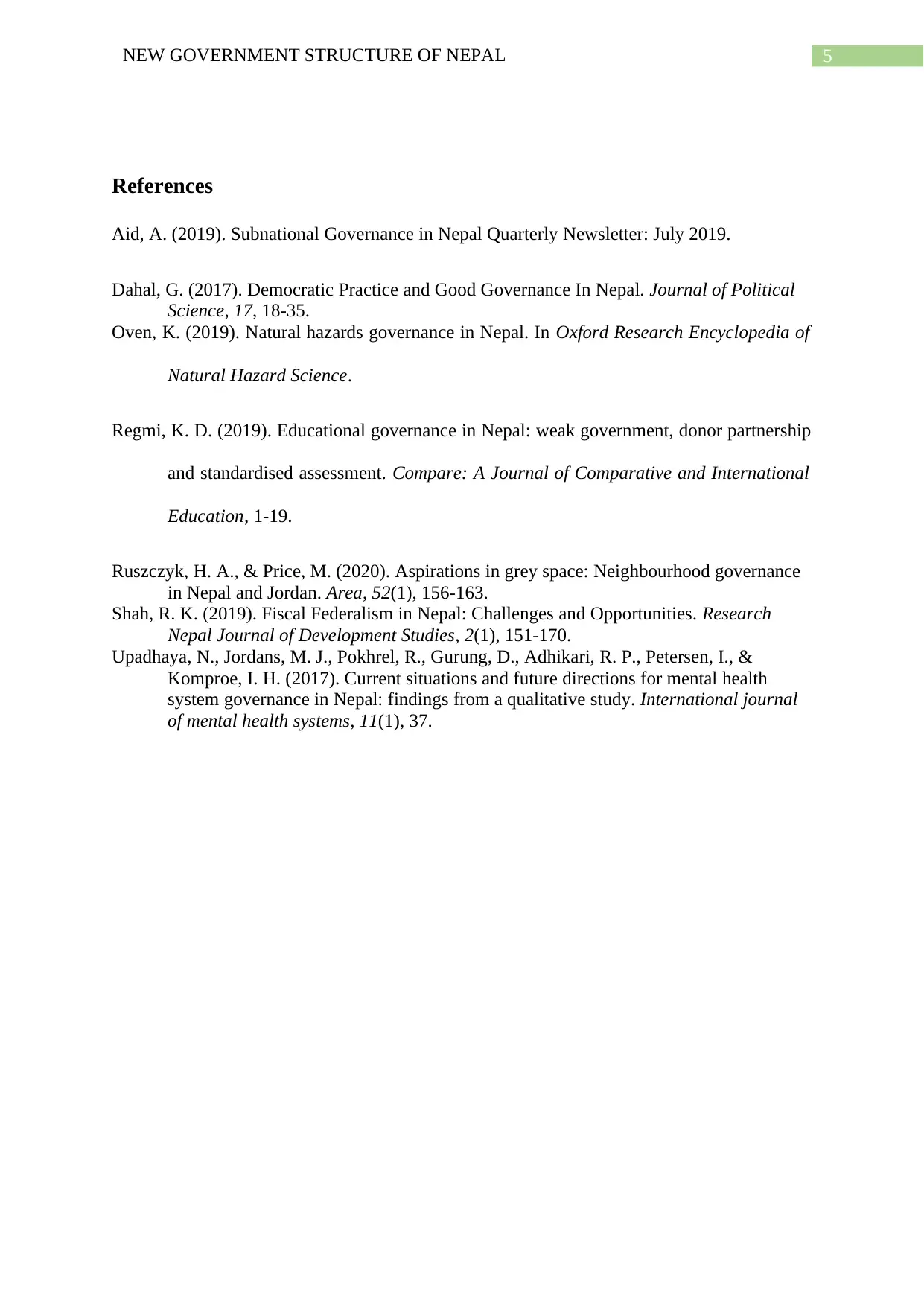
5NEW GOVERNMENT STRUCTURE OF NEPAL
References
Aid, A. (2019). Subnational Governance in Nepal Quarterly Newsletter: July 2019.
Dahal, G. (2017). Democratic Practice and Good Governance In Nepal. Journal of Political
Science, 17, 18-35.
Oven, K. (2019). Natural hazards governance in Nepal. In Oxford Research Encyclopedia of
Natural Hazard Science.
Regmi, K. D. (2019). Educational governance in Nepal: weak government, donor partnership
and standardised assessment. Compare: A Journal of Comparative and International
Education, 1-19.
Ruszczyk, H. A., & Price, M. (2020). Aspirations in grey space: Neighbourhood governance
in Nepal and Jordan. Area, 52(1), 156-163.
Shah, R. K. (2019). Fiscal Federalism in Nepal: Challenges and Opportunities. Research
Nepal Journal of Development Studies, 2(1), 151-170.
Upadhaya, N., Jordans, M. J., Pokhrel, R., Gurung, D., Adhikari, R. P., Petersen, I., &
Komproe, I. H. (2017). Current situations and future directions for mental health
system governance in Nepal: findings from a qualitative study. International journal
of mental health systems, 11(1), 37.
References
Aid, A. (2019). Subnational Governance in Nepal Quarterly Newsletter: July 2019.
Dahal, G. (2017). Democratic Practice and Good Governance In Nepal. Journal of Political
Science, 17, 18-35.
Oven, K. (2019). Natural hazards governance in Nepal. In Oxford Research Encyclopedia of
Natural Hazard Science.
Regmi, K. D. (2019). Educational governance in Nepal: weak government, donor partnership
and standardised assessment. Compare: A Journal of Comparative and International
Education, 1-19.
Ruszczyk, H. A., & Price, M. (2020). Aspirations in grey space: Neighbourhood governance
in Nepal and Jordan. Area, 52(1), 156-163.
Shah, R. K. (2019). Fiscal Federalism in Nepal: Challenges and Opportunities. Research
Nepal Journal of Development Studies, 2(1), 151-170.
Upadhaya, N., Jordans, M. J., Pokhrel, R., Gurung, D., Adhikari, R. P., Petersen, I., &
Komproe, I. H. (2017). Current situations and future directions for mental health
system governance in Nepal: findings from a qualitative study. International journal
of mental health systems, 11(1), 37.
⊘ This is a preview!⊘
Do you want full access?
Subscribe today to unlock all pages.

Trusted by 1+ million students worldwide
1 out of 6
Related Documents
Your All-in-One AI-Powered Toolkit for Academic Success.
+13062052269
info@desklib.com
Available 24*7 on WhatsApp / Email
![[object Object]](/_next/static/media/star-bottom.7253800d.svg)
Unlock your academic potential
Copyright © 2020–2025 A2Z Services. All Rights Reserved. Developed and managed by ZUCOL.





